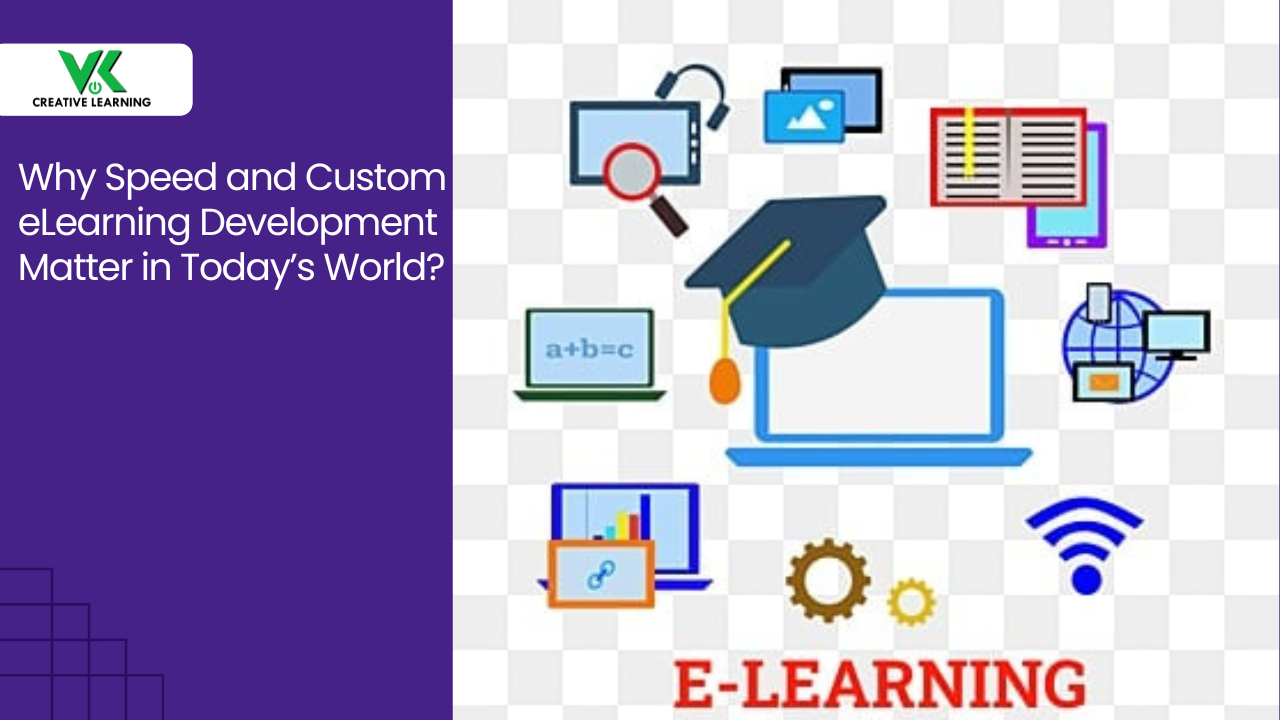How Utilizing Predictive Analytics in eLearning will Enhance Training Sessions?
July 06, 2023
The integration of technology with training has enhanced the landscape of upskilling purposes, offering a path to achieve better performance by harnessing data-driven strategies. Predictive analytics is such a tech that utilizes AI and machine learning capabilities brilliantly to forecast future patterns, analyzing past and present data.
Also in the current digital era, eLearning is shaping up as an essential resource; hence, harnessing predictive analytics comes into play as a powerhouse aid to boost training experiences. Before we understand how predictive analytics can be incorporated into eLearning solutions and its benefit and let us analyze them individually.
More on Predictive Analytics: In essence, predictive analytics delves into copious amounts of information, uncovering valuable patterns and tendencies that ultimately guide judicious choices. This analytical method navigates the labyrinth of data points to unveil hidden gems in the decision-making process. Elaborately put, this analytical method harnesses math algorithms, statistical data analysis models, and machine learning resources to precisely gauge and forecast future prospects in diverse areas.
The Growing Importance of Elearning: Lately, the eLearning realm has witnessed a noteworthy upswing, primarily ascribed to the amalgamation of cutting-edge innovations, seamless availability of materials, and personalized opportunities for both enterprises and learners. Amid the progressive digital transformation, eLearning has established itself as a pivotal catalyst in bolstering training worldwide--even in remote areas. This breakthrough has transformed the approach professionals employ in acquiring knowledge, teaming up, and conveying ideas while chasing personal and professional growth.
Purpose of Using Predictive Analytics in Elearning
Harnessing predictive analytics in eLearning serves a four-pronged function:
- Firstly, pinpointing learning gaps via individual performance analysis, enabling customized training blueprints;
- Secondly, delivering tailor-made learning experiences catering to distinct learner requirements, boosting involvement and drive;
- Thirdly, fine-tuning the educational journey through course content scrutiny and learner engagement evaluations, identifying the most fruitful instruction techniques; and
- Ultimately, elevating learners’ motivation by monitoring progress periodically and proposing extra materials or aid when warranted.
Importantly, by intertwining predictive analytics with eLearning platforms, organizations can efficiently enhance their training sessions while ensuring tangible results for learners.
Enhancing Training Sessions Through Predictive Analytics
Predictive analytics can amp up the training sessions by delivering tailored learning journeys; improved learner engagement and motivation; and efficient resource allocation and management. Let’s look into each of these aspects enhanced by predictive analytics.
Personalized Learning Experiences: Merging predictive analysis with eLearning courseware has paved the way for a plethora of novel prospects for both learners and trainers, transforming the way knowledge is delivered and assimilated.
Personalized learning experiences through predictive analytics can be proffered to the learners by utilizing the approaches of adaptive learning paths and customized content based on learners' performance and interests.
Adaptive Learning Paths: Harnessing predictive analytics in training sessions offers a key advantage: delivering customized learning journeys for every learner. By employing adaptive learning routes, pupils can navigate through bespoke course content, crafted to align with their distinct aptitudes, shortcomings, and learning approaches.
For example, a student grappling with a certain notion may receive extra support to grasp the subject before forging ahead in the curriculum.
Customized Content Based on Students’ Performance and Interests: Besides tailoring learning tracks, predictive analytics also fosters bespoke content suggestions, hinging on a pupil's achievements and inclinations. Such an approach bears immense significance in maintaining learners' enthrallment and drive during their upskilling voyage.
For instance, when a learner exhibits a fervent passion for a distinct discipline, content support for supplementary resources or classes delving deeper into the subject can be proffered. This degree of customization culminates in highly productive training sessions by accommodating manifold learning styles and necessities.
Improved Learner Engagement and Motivation:
In today's training terrain, enhancing trainees' involvement and drive remains paramount. Hence, cutting-edge approaches, including integrating gameplay elements, keeping tabs on learning progress in real-time coupled with responsive evaluations, and connecting remunerations to quantifiable achievements, are picking up steam. Have you wondered what if these three aspects are fused into eLearning with predictive analytics in the picture?
Indeed, incorporating elements of gamification, instant data analysis, and a merit-based system would prove immensely beneficial with predictive analytics playing its part. So let’s dig into these aspects one by one and their contribution to the overall training process.
Gamification: Incorporating gamification elements based on learner preferences--employing predictive analytics, ensures that learning experiences resonate with each trainee's personal interests.
For instance, trainees who thrive in competitive environments might enjoy participating in game quizzes or friendly competitions against their peers. This way, predictive analytics in eLearning can find out their level of interest and ability to learn some concepts quickly.
Real-Time Progress Tracking and Feedback Systems: Real-time monitoring and response mechanisms--through predictive analytics--play a pivotal role in maintaining enduring learner involvement, as they enable learners the opportunity to witness their progress immediately. By surveilling their execution in a real-time manner, pupils can pinpoint aspects necessitating enhancement and modify their learning techniques as needed.
To illustrate, an app for language acquisition might offer immediate counsel regarding enunciation or lexicon utilization, thus enabling the learner to better fathom their strong suits and shortcomings.
Incentives and Rewards Tied to Objective Performance Metrics: Perks and accolades linked to concrete performance indicators using predictive analytics furnish supplementary inspiration for pupils to excel in their academics. By establishing unambiguous objectives connected to tangible incentives analyzed utilizing predictive analytics, learners are spurred on to transcend their existing prowess.
For example, an eLearning platform might integrate a badge scheme or rankings based on performance indicators that acknowledge top-performing students.
Such acknowledgement engenders constructive competition among trainees, ultimately culminating in heightened involvement and enthusiasm for all participants.
--Efficient Resource Allocation and Management
In the contemporary, high-speed business landscape, allocating and maneuvering resources effectively hold the key for enterprises pursuing enhanced results. An approach to accomplish this entails harnessing predictive analytics to heighten the efficacy of training initiatives. Indeed, predictive analytics can be employed to concentrate on three primary facets: pinpointing areas that demand additional scrutiny, fine-tuning the tempo and progression of instructional sessions, and securing enhanced returns on investment. Let's analyze how predictive analytics can be utilized for the same one by one elaborately.
Identifying Areas That Require More Attention or Resources: Predictive analytics can aid in identifying regions that necessitate heightened attention or resources. By scrutinizing past data and spotting patterns in workforce efficacy, executed by predictive analysis, companies can discern skill deficiencies or sectors needing supplementary instruction.
For example, should an organization unearth that staff members consistently fall short within a specific realm, they can allocate added resources to tackle this shortcoming via additional training sessions or other initiatives.
Adjusting the Pace and Sequence of Training Sessions: Employing predictive analytics, firms can customize their educational endeavors for each staff member, taking into account their distinct learning approaches and advancement pace.
Ensuring a Higher Return on Investment for Training Programs: By using smart predictions to check how well different training approaches work in real-time, companies can decide faster and smarter on efficient resource allocation. This results in both a higher ROI and an engaged workforce better prepared to tackle work challenges.
Conclusion
By implementing predictive analytics in eLearning systems, training sessions will become more targeted and efficient. Employing a data-centric strategy, bespoke educational encounters are tailored, adapting seamlessly to each learner's requirements. Finally, with informed decision-making, course designers can fine-tune subject matter to boost pupil involvement and bolster memory retention.
Searching for an adept eLearning development collaborator proficient in weaving predictive analytics into eLearning solutions, then feel free to reach out to VKCL, where a treasure trove of expertise awaits.




